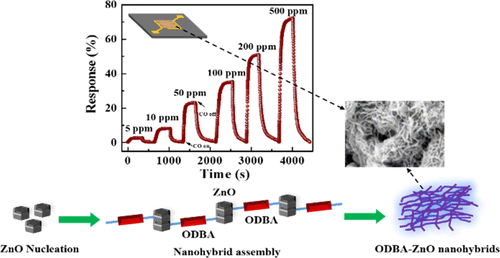当前位置:
X-MOL 学术
›
J. Phys. Chem. C
›
论文详情
Our official English website, www.x-mol.net, welcomes your feedback! (Note: you will need to create a separate account there.)
Organo-di-benzoic-acidified ZnO Nanohybrids for Highly Selective Detection of CO at Low Temperature
The Journal of Physical Chemistry C ( IF 3.7 ) Pub Date : 2020-03-24 , DOI: 10.1021/acs.jpcc.0c01044 Biswajit Mandal 1 , Sayan Maiti 2 , Aaryashree 1, 2 , Gaurav Siddharth 1 , Mangal Das 1 , Ajay Agarwal 3 , Apurba K. Das 2 , Shaibal Mukherjee 1
The Journal of Physical Chemistry C ( IF 3.7 ) Pub Date : 2020-03-24 , DOI: 10.1021/acs.jpcc.0c01044 Biswajit Mandal 1 , Sayan Maiti 2 , Aaryashree 1, 2 , Gaurav Siddharth 1 , Mangal Das 1 , Ajay Agarwal 3 , Apurba K. Das 2 , Shaibal Mukherjee 1
Affiliation

|
A chemiresistive carbon monoxide (CO) gas sensor comprising of an organo-di-benzoic acidified zinc oxide (ODBA-ZnO) nanohybrid material is reported. The ODBA-ZnO hybrid material is prepared via a single-pot hydrothermal method. The electrical resistance of the drop-casted ODBA-ZnO film on interdigitated electrodes increases noticeably upon exposure to CO (5–500 ppm). The resistance increase is attributed to the formation of complex ions at the organic (ODBA)–inorganic (ZnO) interface in the presence of CO. The detailed CO sensing properties of the ODBA-ZnO nanohybrids reveal a remarkable selectivity to CO gas in comparison to other gases like CO2, H2S, and NH3 at 125 °C. The maximum response to 100 ppm of CO is observed to be 35% with the achieved selectivity to CO being 88%, which is the best reported CO selectivity result available in the literature to date. The ODBA-ZnO nanohybrid sensor takes nearly 91 s to reach the saturated response to 100 ppm of CO and nearly 175 s to recover from it in a synthetic air environment. A systematic study using field emission scanning electron microscopy, X-ray diffraction, energy-dispersive X-ray spectroscopy, nitrogen adsorption–desorption tests, and thermogravimetric analysis reveals that introduction of an organic moiety (ODBA) to ZnO played a key role in achieving improved selectivity and sensitivity toward CO. The present work provides a simple route for fabricating the ODBA-ZnO sensor to achieve better selectivity and sensitivity to CO gas at a relatively low temperature (125 °C).
中文翻译:

有机二苯甲酸酸化的ZnO纳米杂化物用于低温下CO的高选择性检测
报道了一种化学阻性一氧化碳(CO)气体传感器,该传感器包括有机二苯甲酸酸化氧化锌(ODBA-ZnO)纳米杂化材料。ODBA-ZnO杂化材料是通过单锅水热法制备的。当暴露于CO(5-500 ppm)时,叉指电极上滴铸的ODBA-ZnO膜的电阻显着增加。电阻的增加归因于在存在CO的情况下在有机(ODBA)-无机(ZnO)界面上形成了复杂的离子。ODBA-ZnO纳米杂化物的详细CO感测特性表明,与其他气体,例如CO 2,H 2 S和NH 3在125°C下。观察到对100 ppm CO的最大响应为35%,对CO的选择性达到88%,这是迄今为止文献中报道的最佳的CO选择性结果。在合成空气环境中,ODBA-ZnO纳米混合传感器需要近91 s才能达到对100 ppm CO的饱和响应,而要花费近175 s才能从其中恢复。使用场发射扫描电子显微镜,X射线衍射,能量色散X射线光谱,氮吸附-解吸测试和热重分析的系统研究表明,向ZnO中引入有机部分(ODBA)在实现提高了对CO的选择性和灵敏度。
更新日期:2020-03-26
中文翻译:

有机二苯甲酸酸化的ZnO纳米杂化物用于低温下CO的高选择性检测
报道了一种化学阻性一氧化碳(CO)气体传感器,该传感器包括有机二苯甲酸酸化氧化锌(ODBA-ZnO)纳米杂化材料。ODBA-ZnO杂化材料是通过单锅水热法制备的。当暴露于CO(5-500 ppm)时,叉指电极上滴铸的ODBA-ZnO膜的电阻显着增加。电阻的增加归因于在存在CO的情况下在有机(ODBA)-无机(ZnO)界面上形成了复杂的离子。ODBA-ZnO纳米杂化物的详细CO感测特性表明,与其他气体,例如CO 2,H 2 S和NH 3在125°C下。观察到对100 ppm CO的最大响应为35%,对CO的选择性达到88%,这是迄今为止文献中报道的最佳的CO选择性结果。在合成空气环境中,ODBA-ZnO纳米混合传感器需要近91 s才能达到对100 ppm CO的饱和响应,而要花费近175 s才能从其中恢复。使用场发射扫描电子显微镜,X射线衍射,能量色散X射线光谱,氮吸附-解吸测试和热重分析的系统研究表明,向ZnO中引入有机部分(ODBA)在实现提高了对CO的选择性和灵敏度。



























 京公网安备 11010802027423号
京公网安备 11010802027423号